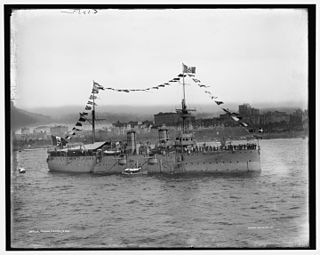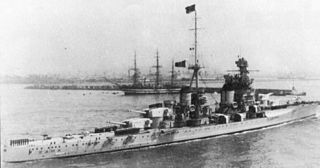 W
WAgordat was a torpedo cruiser of the Italian Regia Marina built in the late 1890s. She was the lead ship of the Agordat class, which had one other member, Coatit. The ship, which was armed with twelve 76 mm (3 in) guns and two 450 mm (17.7 in) torpedo tubes, was too slow and short-ranged to be able to scout effectively for the fleet, so her career was limited. She saw action during the Italo-Turkish War in 1911–12, where she provided gunfire support to Italian troops in North Africa. She assisted in the occupation of Constantinople in the aftermath of World War I, and in 1919 she was reclassified as a gunboat. In January 1923, Agordat was sold for scrapping.
 W
WCoatit was a torpedo cruiser of the Italian Regia Marina built in the late 1890s. She was the second and final member of the Agordat class. The ship, which was armed with twelve 76 mm (3 in) guns and two 450 mm (17.7 in) torpedo tubes, was too slow and short-ranged to be able to scout effectively for the fleet, so her career was limited. She saw action during the Italo-Turkish War in 1911–12, where she provided gunfire support to Italian troops in North Africa. She also caused a minor diplomatic incident from an attack on retreating Ottoman soldiers in Anatolia. Coatit was part of an international fleet sent to Constantinople when the city appeared to be at risk of falling to the Bulgarian Army during the First Balkan War. In 1919, she was converted into a minelayer and was sold for scrap in 1920.
 W
WEtna was a protected cruiser of the Italian Regia Marina built in the 1880s. She was the lead ship of the Etna class, which included three sister ships. Named for Mount Etna on the island of Sicily, the ship was laid down in January 1883, was launched in September 1885, and was completed in December 1887. She was armed with a main battery of two 10-inch (254 mm) and six 6-inch (152 mm) guns, and could steam at a speed of around 17 knots.
 W
WThe Etna class was a series of protected cruisers that were built in the late 1880s for the Regia Marina. The four ships built were slightly enlarged copies of the Elswick Works' design for the protected cruiser Giovanni Bausan. Etna, the lead ship of the class, was the only ship still in service when World War I began, although she served as a stationary headquarters ship for the Navy Commander-in-Chief in Taranto for the duration of the war. The three later ships all participated in putting down the Boxer Rebellion as part of the Eight-Nation Alliance. The three were struck from the Navy List before 1912, but Etna was not sold for scrap until 1921.
 W
WEttore Fieramosca was a protected cruiser of the Italian Regia Marina built in the 1880s. She was the fourth and final member of the Etna class, which included three sister ships of slightly smaller dimensions. Named for the condottiero of the same name, she was the only member of her class not named for a volcano. The ship was laid down in December 1885, launched in August 1888, and was commissioned in November 1889. She was armed with a main battery of two 10-inch (254 mm) and six 6-inch (152 mm) guns, and could steam at a speed of 18 knots.
 W
WThis is a list of all modern cruisers built by Italy, starting from the 1880s.
 W
WFrom the 1880s to 1910s, the Italian Regia Marina built or purchased twenty protected cruisers; the earliest vessels were either built or designed in Britain, though later vessels were constructed in Italy, to Italian designs. Several of these cruisers were ground-breaking warships: Dogali was the first major warship equipped with triple-expansion engines and Piemonte was the first warship armed entirely with quick-firing guns. The first two designs, Giovanni Bausan and the Etna class, were armed with large-caliber guns and marked a brief experimentation with the Jeune École in the 1880s, which represented a shift away from expensive battleships in favor of cheaper vessels that could theoretically destroy battleships easily. Italian naval strategists quickly discarded the concept and returned to more traditional strategies centered on a fleet of battleships. As a result, later cruisers returned to medium-caliber batteries.
 W
WMarco Polo was an armored cruiser built for the Royal Italian Navy in the 1890s, the first of her type in Italian service. The ship spent the bulk of her career deployed in the Far East. Between deployments she participated in the Italo-Turkish War of 1911–12 during which she caused a diplomatic incident with the Austro-Hungarian Empire. After that affair Marco Polo was sent to Libya where she bombarded the towns of Homs, and Zuara and the defenses of the Dardanelles. In between these operations, the ship provided naval gunfire support to the Royal Italian Army in Libya. Due to her age, Marco Polo did not play a significant role in World War I, serving as an accommodation ship in Venice until she began conversion into a troopship in 1917. After a series of renamings in 1920–21, the ship was stricken from the naval register in 1922 and subsequently sold for scrap.
 W
WStromboli was a protected cruiser of the Italian Regia Marina built in the 1880s. She was the second member of the Etna class, which included three sister ships. She was named for the volcanic island of Stromboli, and was armed with a main battery of two 10-inch (254 mm) and six 6-inch (152 mm) guns, and could steam at a speed of 17 knots. Her career was relatively uneventful; the only significant action in which she took part was the campaign against the Boxer Rebellion in China in 1900. She returned to Italy in 1901 and spent the rest of her career in reserve or as an ammunition ship, apart from a brief stint in active service in 1904. Stromboli was stricken from the naval register in 1907 and sold for scrapping in 1911.
 W
WVesuvio was a protected cruiser of the Italian Regia Marina built in the 1880s. She was the third member of the Etna class, which included three sister ships. Named for the volcano Mount Vesuvius, the ship's keel was laid down in July 1883. She was launched in March 1886 and was commissioned into the fleet in March 1888. She was armed with a main battery of two 10-inch (254 mm) and six 6-inch (152 mm) guns, and could steam at a speed of around 17 knots. Her career was relatively uneventful; the only significant action in which she took part was the campaign against the Boxer Rebellion in China in 1900. She was stricken from the naval register in May 1911 and sold for scrap in 1915.
 W
WThe Vettor Pisani class consisted of two armoured cruisers built for the Royal Italian Navy in the 1890s. The two ships of the class, Vettor Pisani and Carlo Alberto, were frequently deployed overseas during their careers. The former served in the Far East during the Boxer Rebellion of 1900 while the latter was involved in pioneering long-range radio experiments several years later before deploying to South American waters. Carlo Alberto then served as a training ship for several years. Both ships participated in the Italo-Turkish War of 1911–12 and played minor roles in World War I, during which time Carlo Alberto was converted into a troop transport and Vettor Pisani into a repair ship. They were both discarded in 1920 and subsequently scrapped.